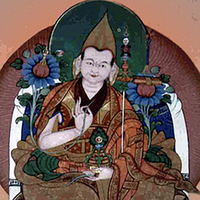
Ngulchu Dharmabhadra
Ngulchu Dharmabhadra (dNGul-chu d+harma b+ha dra), a towering figure in the Gelug tradition of Tibetan Buddhism, lived during a period of rich spiritual and philosophical development. Renowned for his scholarly achievements and deep spiritual practice, he played a crucial role in elucidating and spreading the teachings of Je Tsongkhapa (rJe Tsong-kha-pa), the founder of the Gelug school of Tibetan Buddhism.
Born in 1772 into a poor family in Rongtö Chugmo (Rong-stod phyug-mo), located in central Tibet, he learned reading and writing from his uncle Genpo Lhabu (rGan-po lha-bu), and by the age of 14 he had joined Tashi Gepel Ling Monastery (bKra-shis dge-’phel-gling) and received the vows of a novice monk. Around 1790, his mother, brother, and aunt all died, compelling him to seek the life of a true renunciate. He moved to Ngulchu Hermitage (dNGul-chu ri-khrod) and received full monastic ordination from Lobpon Yeshe Peldrup (sLob-dpon ye-shes dpal-grub).
He pursued education primarily at Tashilhunpo (bKra-bshis lhun-po), where he studied under eminent scholars such as Guge Yongdzin Losang Tenzin (Gu-ge yongs-'dzin blo-bzang bstan-'dzin, 1748-1813), mastering the traditional subjects of Prajñāpāramitā, Madhyamaka, Pramāṇa, Vinaya, and Abhidharma. His intellectual rigor and spiritual depth were evident in his mastery of both sutra and tantra, contributing significantly to the Gelug curriculum.
His extensive writings, including commentaries on key Indian and Tibetan Buddhist texts, highlight his contributions to Buddhist philosophy. Through his works, Ngulchu Dharmabhadra sought to clarify and disseminate the teachings of Tsongkhapa, focusing on the essence of Madhyamaka philosophy and its practical applications in spiritual practice. He also composed various sadhanas and commentaries on empowerments, as well as important texts on poetry and Tibetan grammar. Ngulchu Dharmabhadra emphasized the importance of the lam-rim and lojong teachings, providing accessible and profound guidance for practitioners. His approach to meditation and spiritual practice, deeply rooted in Tsongkhapa's teachings, influenced the development of contemporary Gelug practices.
After the age of 35, apart from teaching at monasteries in the Central Tibet region, he spent most of his time engaged in meditation retreats until he passed away at the age of 80 in 1851.
Ngulchu Dharmabhadra's contributions to the Gelug tradition and to Tibetan Buddhism as a whole are profound and enduring. His life and works continue to inspire practitioners and scholars, embodying the integration of rigorous intellectual discipline with profound meditative realization.